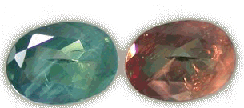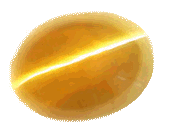Chrysoberyl
Several stones are chatoyant, that is they show a "cat's eye" effect.
Those without the cat's eye are faceted, often as mixed cut and have a brilliant play of light.
The chrysoberyl name comes from the Greek: 'chrysos' (gold) as many of the stones are golden, alexandrite is green but displays as red under incandescent light.
|Structure: Othorhombic|Composition: Beryllium aluminium oxide|Moh's Hardness: 8½|
Alexandrite

Natural Alexandrite
Containing chromium it is a curious gem showing green in daylight, but violet/red in incandescent light.
It is these properties which make it highly sought after, with many imitations.
The original source of this stone has been exhausted. Modern alexandrite is likely to be from Brazil, Sri Lanka, Burma Tanzania, Colorado (USA) or Conneticut (USA).
|Structure: Othorhombic|Composition: Beryllium aluminium oxide|Moh's Hardness: 8½|
Cat's Eye
Cat's eye chrysoberyl gets its chatoyancy from tiny inclusions, cabochon are cut to enhance the "Cat's Eye" effect. The most expensive and popular type is yellow/white known as "milk and honey".
| Latest Trends | Ordering Information | debbie@silkpixie.com | Delivery & Returns |


